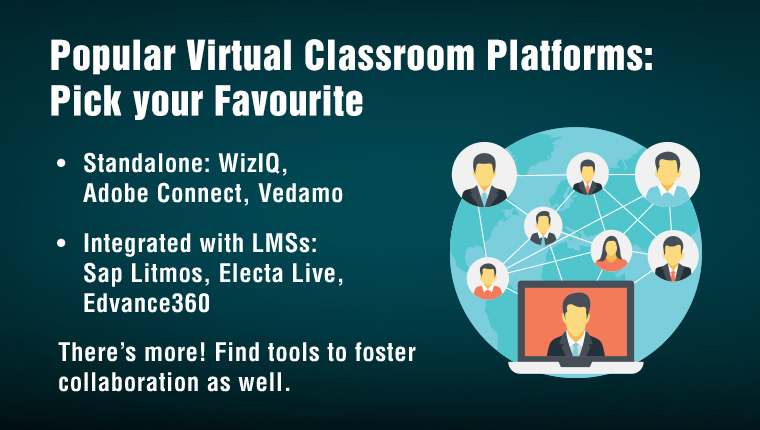The Science of VILT: 5 Platforms to Make Virtual Classrooms a Reality

Designing the perfect training program takes a lot of planning and smart decision making. Whenever we work on a virtual instructor-led training (VILT) program for a client, we are asked this question:
“Of all the options out there such as Zoom, Adobe Connect, Microsoft Teams, and Cisco Webex which one should we choose?”
Our response?
“It depends entirely on your training requirement”.
→ Register for a webinar on converting classroom training to VILT.
I know that isn’t the most straightforward answer, but it is what it is. All VILT platforms have some common, minimum features such as chat, video conferencing, polling, and recording. Beyond these essentials, modern VILT platforms also offer whiteboards, breakout rooms, gamification, video sharing, and even integration with other platforms. When we’re not sure about which platform to choose, we often ask our clients these questions:
- Which virtual method of instruction do you want to employ for the training?
- Will you be using eLearning through a Learning Management System (LMS) alongside the VILT?
The answers to these questions will make choosing the right VILT platform, if not easy, at least not too complicated. In this blog, we’ll look at different VILT platforms and compare them on 9 different criteria/elements.
- Chat
- Polling
- Screen-sharing
- Recording
- Whiteboard
- Breakout rooms
- Mobile app
- Security
- Integration with other platforms
5 VILT Platforms for Your Virtual Classrooms – A Comparison
1. Adobe Connect
If you are looking for an engaging, feature-rich VILT platform that ensures your training information remains secure, you can’t go wrong with Adobe Connect. It gives you an immersive virtual classroom environment that not only has common features like chat, online polls, and discussion forums, but takes interactivities and learner engagement to the next level using persistent rooms, breakout rooms, and backstage tools.
“Heard of breakout rooms but what exactly are persistent rooms and backstage tools?”
Well, persistent rooms can be best described as personalized virtual classrooms that are used for specific training topics by instructors. Each persistent room comes with its own content library where instructors can store the media assets and files that they use during training sessions. These persistent rooms can be customized using templates to reflect the kind of training it is used for. You can set up 200 live virtual classroom sessions with these persistent rooms and reuse them again and again.
Breakout rooms, as you must know, are tools that provide learners to participate in group activities. It facilitates interaction, brainstorming and collaborative learning. Adobe Connect allows you to set up 20 breakout rooms in a single VILT session.
On the other hand, backstage tools are more for the instructors’ benefit and help them in making the training session an engaging and seamless process. It gives them a ‘behind the scene’ space to collaborate with other instructors, chat, share notes, files and resources, prepare online polls and discuss results of polls and activities privately.
Adobe Connect also allows the recording, editing, and streaming of live training videos for on-demand learning. It can use API plugins to easily integrate with several LMSs and can work alongside Adobe proprietary platforms and tools like the Captivate authoring tool and Adobe Illustrator to build quizzes, simulations, and other interactivities for the virtual classroom.
All these interactive learning elements can be easily accessed through mobile devices (both Android and iOS). Adobe Connect comes as a mobile app for both Android and iOS devices and can track learners’ activities during the VILT session and provide detailed analytical reports based on them.
2. Cisco Webex
The Cisco Webex platform was designed on a simple yet powerful concept of ‘keeping your team connected and your work secure’. While it was primarily used for business meetings and maintaining open communication channels within an organization, the recent COVID-19 lockdown has seen this platform suddenly emerge as a frontrunner in virtual classroom platforms.
It allows hassle-free video conferencing. Most importantly, since it was designed to accommodate large scale virtual events, it places no limitations on the number of participants when used for a virtual classroom.
Apart from the usual chat and screen-sharing features, Cisco Webex has an interactive whiteboard and file sharing features for collaborative learning. It also allows video-based breakout sessions during VILT sessions. It is a mobile-friendly platform that allows you to call and connect with other team members and participants anytime, anywhere, through the device of your choice.
Perhaps the most important feature of Cisco Webex is its ability to integrate with a range of external platforms, be it cloud-based, file-sharing, social media, or sales management. It can effectively work in-sync with your Google Drive and Calendar, MS Outlook, Twitter, and Salesforce, to name just a few.
But working with external platforms doesn’t mean Cisco Webex lacks in data security. It provides end-to-end encryption of shared files and works with Data Loss Prevention (DLP) and Cisco Cloudlock to provide an uber-secure platform for VILT sessions.
3. Vedamo
While more and more organizations are opting for virtual instructor-led training (VILT) everyday, especially after the COVID-19 lockdown, there is one challenge they often face that makes them apprehensive about virtual classrooms. The challenge is to make classroom instructors comfortable with using technology and navigating VILT platforms. As a remedy to this particular problem, more and more off-the-shelf ‘training the trainers’ courses are gaining popularity.
While ‘training the trainers’ is certainly a good initiative, it can also become time-consuming and does not offer a rapid solution. And this is precisely what sets Vedamo apart from scores of other VILT platforms available in the market. While most VILT platforms focus on engaging interactivities and extraneous features, Vedamo focuses on making instruction easy for instructors. It is a platform designed by instructors for instructors, and prides itself on having the most user-friendly interface of them all.
And being user-friendly doesn’t mean it lacks in making learning engaging through interactive features. Vedamo has a rich set of tools same as any other VILT platform like online whiteboards, screen-sharing, and virtual breakrooms; it is only extremely easy to navigate and use these tools. Vedamo is also a mobile responsive VILT platform that allows learners the flexibility learning through a device of their choice.
4. MS Teams
While choosing a VILT platform, an often-overlooked point is whether the platform was designed for business communication or for virtual classrooms. And most of the time, it works fine either way as both kinds of platforms have unique features that can be leveraged. For instance, Adobe Connect is a virtual classroom platform and hence has persistent rooms, break rooms, and backstage tools dedicated to collaborative learning.
On the other hand, Cisco Webex is designed for business communication, and that is why it can be used for scaling up the number of participants like no other tool. But if you want a perfect middle ground between a VILT platform and a business communication platform, you can’t do better than Microsoft Teams.
Microsoft Teams unifies communication and collaboration through the virtual platform, allowing workplace chats, video meetings, file storage and sharing, as well as breakout sessions, screen sharing, and recording. It can be used for calling internal team members as well as for hosting web conferences with external audiences, and conducting live events. It also comes as a mobile app for anytime, anywhere learning.
5. Panopto
Unlike other platforms we have discussed so far, Panopto is not a video conferencing platform but rather a video recording and sharing platform. It can work in collaboration with other VILT platforms as well as LMSs to deliver video-based learning to your employees. The platform advocates that asynchronous video-based training is perhaps the most effective way to train remote learners.
It provides a secure video library to curate and access training videos of all types, be it live recording of a VILT session, user-generated recording, slide-based recording of presentations with in-sync webcam videos, flipped classrooms, and more.
Panopto videos are also Section 508 compliant. They can be used in collaboration with Zoom, and allow integration with most LMSs.
VILT Platforms: A Summary of Comparison
| Adobe Connect | Cisco Webex | Vedamo | MS Teams | Panopto | |
| Chat | ✓ | ✓ | ✓ | ✓ | |
| Polling | ✓ | ✓ | ✓ | ✓ | |
| Screen-sharing | ✓ | ✓ | ✓ | ✓ | |
| Recording | ✓ | ✓ | ✓ | ✓ | ✓ |
| Whiteboard | ✓ | ✓ | ✓ | ||
| Breakout Rooms | ✓ | ✓ | ✓ | ✓ | |
| Mobile App | ✓ | ✓ | ✓ | ✓ | |
| Security | ***** | ***** | *** | **** | **** |
| Integration with external platforms | With Adobe proprietary platforms such as Captivate Prime LMS | With a range of external platforms such as MS Outlook, Google Drive, Twitter, and Salesforce | With Vedamo LMS | With Microsoft tools and services as well as with Salesforce and a few LMSs | With a range of LMSs available in market |
Summing it Up!
With so many platforms flooding the marketplace, choosing the right one is no cake walk. It needs some research and smart decision making. I hope this blog on different VILT platforms has given you enough insights to make the right choice and get started with your virtual classroom training initiatives.
For more insights on effective virtual training, download our eBook.




![Top 3 VILT Platforms and Their Noteworthy Features [Explained]](https://blog.commlabindia.com/hubfs/Imported_Blog_Media/Top-3-VILT-Platforms-and-Their-Noteworthy-Features-Explained.jpg)
